408 to 1.
That's the national student-to-counselor ratio as per the U.S. Department of Education National Center for Education Statistics for the academic year 2021–2022.
The recommended ratio: 250 to 1.
Let that sink in.
Picture this: a batch of 400+ students who are about to graduate, and ONE career counselor for all of them. ONE person to ensure that they are all equipped to kick-start their professional journey after college.
ONE person who is tasked with providing personalized career guidance to all students.
To understand their unique interests and inclinations, to identify all the career options that align with how they see themselves as individuals.
To prevent them from making the usual mistakes that people commit in the beginning of their careers.
Do you think that's fair? Not only to those 400+ students, but to that ONE career counselor who's tasked with optimizing career readiness for them all?
We at Hiration certainly don't think so. We empathize with not just the students but the career services teams who are asked to climb Mt. Everest with nothing but a stick.
We understand the numerous challenges facing these teams that limit their efforts and ability to help students navigate this transition.
The discrepancy between the recommended and actual student-to-counselor ratio is undeniable. Career services teams face increased pressure to provide optimal and personalized guidance to students pertaining to career exploration, job search assistance, resume and cover letter reviews, and mock interview assessments.
Hiration is committed to researching the impact of career centers on student success and delving deep into the challenges they face while striving to deliver optimal career outcomes for students. By understanding the obstacles encountered by career services teams, key stakeholders and decision-makers can implement effective solutions tailored to the unique needs of their institutions.
Here's an in-depth analysis of the key challenges experienced by career services teams at US colleges and universities.
Budget Constraints
The pandemic made it clear that career centers would need out-of-the-box ideas to meaningfully engage with students and guarantee career outcomes in an uncertain job market. Consequently, the administration needed to invest more resources to ensure the same.
However, for fall 2020, 17% of career services teams reported a reduction in their budgets by more than 10% vis-à-vis the previous year, as per a poll conducted by NACE (National Association of Colleges and Employers).
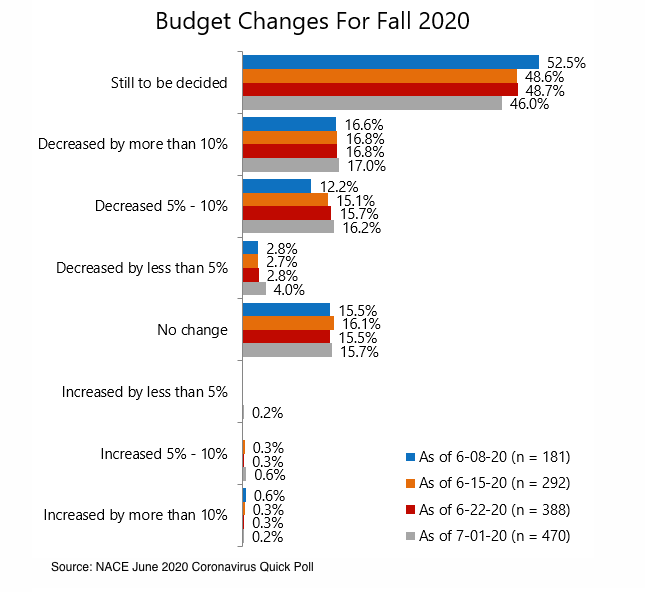
Image Source: Paragon One
NACE published its 2020-21 Career Services Benchmark Survey Report. Based on the inputs of 538 respondents across the country, it concluded that more than one-third of career services centers (33.6%) experienced personnel budget cuts. To put this in context, more than 36% had reported an increase in their personnel budgets the year before that. Moreover, 56.7% faced reductions in their non-personnel budgets following the pandemic.
As per the 2021-22 Career Services Benchmark Survey Report which had 587 respondents, we found that 32% of career centers reported an increase in their personnel budgets while 17% reported cuts. Considering that more than a third of them had slashed their personnel budgets in the previous year, this 32% jump, while encouraging, is not ideal. The non-personnel budgets kept on falling further, with more than a third of the respondents reporting a cut.
With tight budgets, career services teams face difficulties in providing students access to up-to-date resources, counselors, tools, and technology necessary for navigating the job market.
They may also have difficulty hiring and training enough staff to meet the needs of students seeking career guidance.
Additionally, limited funding makes it difficult for career services teams to market and outreach students and even provide competitive salaries to staff members which can have a negative impact on the overall success of career services and student outcomes.
For instance, here's a review by a career counselor from George Washington University on Glassdoor:
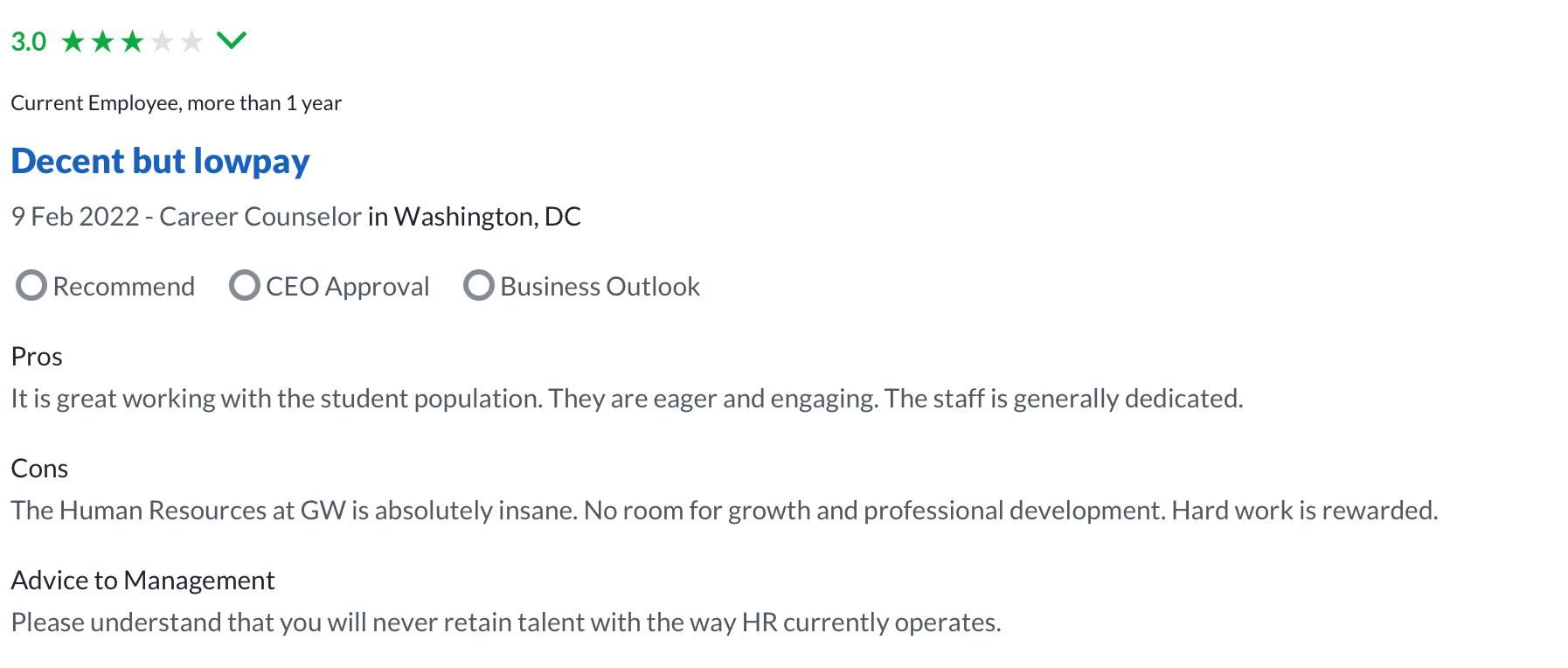
With budget cuts as an ever-present sword of Damocles hanging over career centers, how can they help students crack the job market? This at a time when, as per The American Freshman Report published by the Cooperative Institutional Research Program, more than 80% of students admit that securing a job is a key factor in their decision to enroll for university?
Student Outreach & Awareness
In a 2021 poll conducted by NACE which saw the participation of 455 universities, student outreach was ranked as the biggest challenge facing career centers, with almost a third of the responding offices (29%) placing it above the usual suspects like budgetary constraints, lack of resources, or even the pandemic.
Despite extensive efforts to promote events and collaborate with DEI offices, reaching out to students is still difficult. Moreover, securing attendance at events/fairs and increasing career center visits is particularly challenging.
This is not to say that nothing is being done. For instance, the Career Center at the University of Illinois practices early outreach to students and focuses on freshmen to increase their sense of urgency for career planning, raise awareness of campus career services, lower barriers, and provide more incentives and support. This aligns with the goals of the 2013 NASPA Career and Professional Aspirations Survey involving participation of 31 institutions, which encourages career services professionals to explore opportunities for early outreach to students in their academic careers.
To get some more context, here is the breakup of respondents based on users and non-users of their career services:

The ongoing pandemic has complicated student outreach efforts and added hindrances that make it even more challenging to connect with students. The Student Voice Survey conducted by Inside Higher Ed and College Pulse revealed that about 33.33% of students expressed that they would have participated in more career service activities and events had they been held in person.

The widespread use of digital platforms for communication and service management has created a need for staff training and up-skilling, the absence of which only hampers all outreach initiatives.
The challenges of the pandemic, including connectivity and equipment issues, maintaining work-life balance at home, ensuring staff well-being, etc. have placed additional strain on career services teams. These are all plausible factors that affect student outreach and engagement since the earlier difficulties pertaining to outreach are now worsened by throwing remote communication into the mix.
The challenge of student outreach becomes more complicated when we include racial/ethnic minorities in the equation. For instance, the need to have better support for first-generation students has been overlooked, as these groups of students face uniquely additional set of challenges such as little to no guidance while navigating college admissions, financial aid, and coursework, which makes it harder for them to achieve postsecondary success.
A NASPA study showed that only 55% of first-generation students made use of career services and are 24% less likely to use academic advising services.
Sarah Whitley, vice president of the Center for First-Generation Student Success, says, “Institutions can be such complex bureaucratic and jargon-filled entities it can be difficult for first-generation students to access the support and resources imperative to their success. First-generation students are often academically prepared and very talented - it’s just that sometimes they lack the information and resources needed to select the best institution for them, to understand the admissions and financial aid process, and to know the right questions to ask along the way.”
We'll explore the specific challenge of Diversity, Equity and Inclusion (DEI) separately below, but to conclude here, student outreach as a challenge can be addressed by incorporating technology in existing processes.
Hiration's edtech platform is a specialized offering that acts as the operating system for career centers. You can easily manage and monitor the end-to-end student lifecycle and also automate the entire outreach process in a jiffy, leaving you with more time to do what actually matters.
Hurry! Click here to learn more and book a free demo now!
Lack of Staff
About 38% of career centers at various colleges and universities have implemented a hiring freeze, according to a recent poll conducted by NACE.
NACE’s 2020-21 Career Services Benchmark Survey Report concluded that the median office FTE (professional and admin roles) decreased from 7.5 in 2019-20 to 6.3 in 2020-21, while the mean decreased from 10.9 to 9.8. The mean for total professional staff per office also decreased from 6.6 to 6.1.

Even in 2021-22, the median for total office professional and administrative support roles (FTE) was unchanged at 6.3, while the mean marginally lowered from 9.8 to 9.6.
In an article by Hechinger Report, Katie Smith, who has worked as a career advisor for students at Elon University and Duke University in North Carolina, said:
"In a time of economic recession, especially to the scale that we’re seeing right now, any lack of funding towards these services seems like it could be especially problematic."
Largely influenced by the primary challenge of limited budget, career services teams in US colleges and universities are limited by a lack of adequate staff, which can pose significant hurdles for students seeking career guidance.
The lack of qualified career services professionals to assist students can result in longer delays for appointments, inadequate one-on-one support, and limited access to the latest job market trends and technologies.
During high demand, such as the beginning of an academic year or placement season, a shortage of staff can make it challenging for career services teams to keep up with the needs of their students.
Additionally, the limited availability of staff can impact the effectiveness of career services teams in providing personalized guidance and support, which can negatively affect a student's chances of success in the job market.
If hiring is out of the equation due to budget constraints, the shortage of staff can be countered by investing in AI technology.
Hiration's AI-powered edtech platform with advanced capabilities to enable cohort-wide resume reviews is trusted by 100+ career services teams. What are you waiting for? Book a free demo now!
Increasing Demand, Decreasing Coverage
Before we talk about career services in particular, it's important to take a step back and discuss how students view college education in general.
Higher education enrollment in the US has been on a decline for ten consecutive years. Moreover, young people thinking that college is important has gone down by 50% in the last 6 years.
Only about 26% of all graduates strongly agreed that they learned something important in college and that their college courses were relevant to their jobs. However, they are 5.5x more likely to strongly agree that their education was worth the cost.
Pertaining to career services, graduates who rated their experiences with them as “very helpful” are 5.8x more likely to strongly agree that their college prepared them for post-graduation life and 3.4x more likely to recommend their alma mater. Unfortunately, only 8% of all graduates not only visited their career centers but also found them to be “very helpful.”
A report by NACE indicated that just 25.6% of students visited career centers for internships while only 20.8% participated in mock interviews, and 21.1% visited the center for networking preparation.
Overall, the average number of students that career centers assisted with finding internships fell from 446.4 in 2021 to 291.8 in 2022, while the median fell by approximately 20 students.
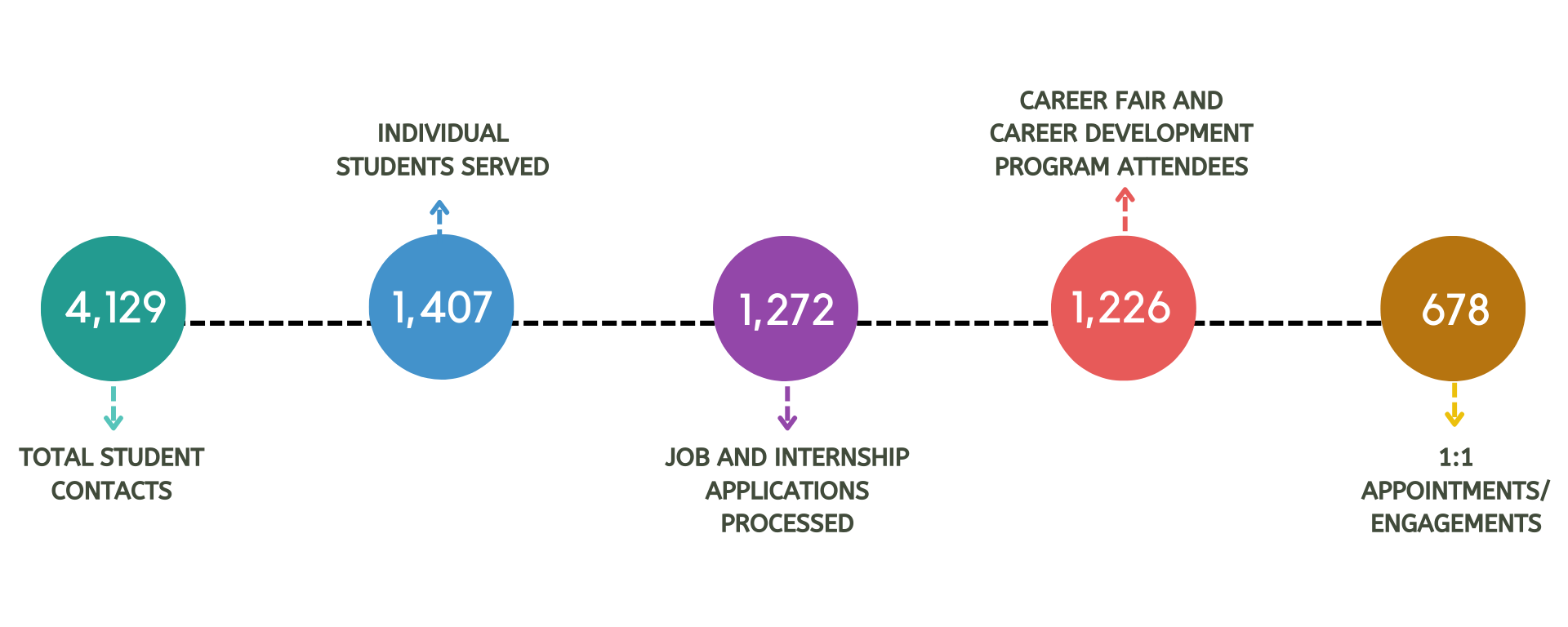
Source: Indiana University South Bend
While the shift towards virtual learning and remote work has made it even more challenging for career services teams to engage with students, the actual demand for career services is on a rise.
A NACE report showed that virtual career counseling/coaching by appointment has nearly doubled from last year.
Meanwhile, in-person appointments rose nearly 28% from 827 to 1,055 between 2017 and 2019.
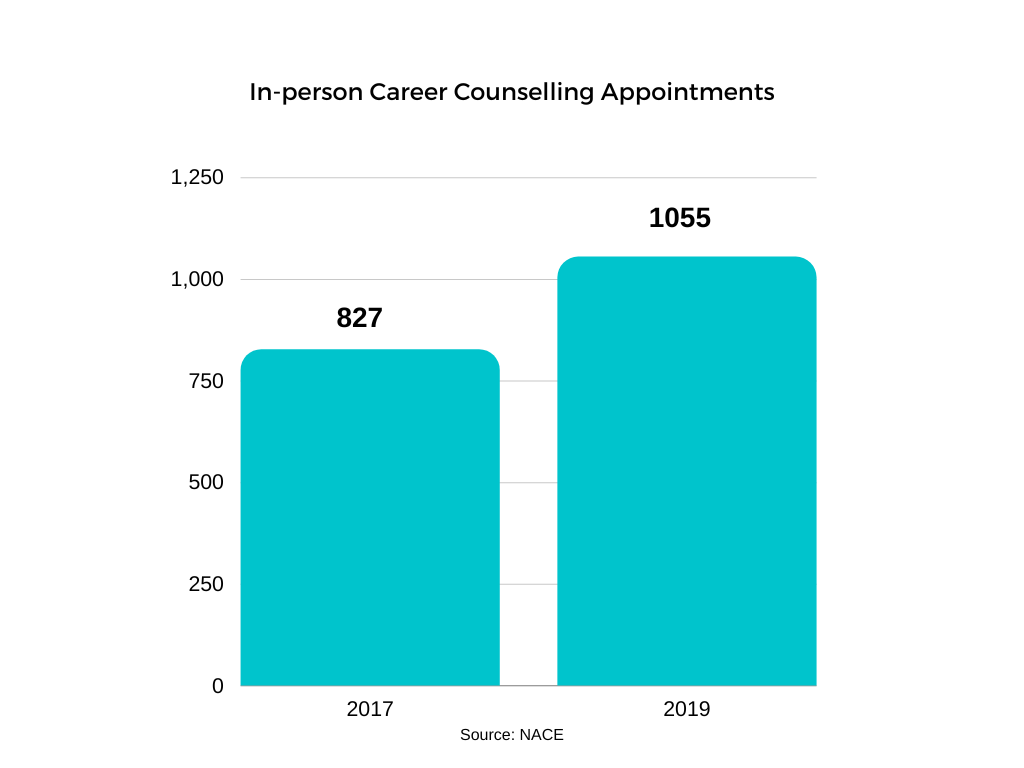
This trend in particular - of increasing demand for career services followed by students not deeming them to be very helpful - is both an obstacle and an opportunity.
A robust feedback mechanism can help the administration accurately identify areas for improvement. A competitive job offer right after college is clearly the top priority for students when they enroll, and career centers are well positioned to address that requirement - provided they are aware of where they are lacking and where they can double down on their strengths.
Inadequate Data Management
For context, more than three-quarters of career centers in the USA do not report demographics of students who are using their services. This gap in gathering meaningful data is a significant barrier in accurately assessing equity and effectiveness of outcomes.
A global survey conducted by StudyPortals and iE&D Solutions showed that 59% of the respondents do not use a CRM system at all (out of 176 respondents).
Lack of awareness and knowledge about CRMs was adjudged as the primary reason why most of the colleges were not using a CRM system. Some even admitted to hearing about "CRM" for the first time. The second major barrier was attributed to a lack of budget.
Even in cases where CRMs were being used, the departments of recruitment and admissions took the lead in its usage, leaving career services behind.

Coming specifically to the USA, a report by AACRAO (American Association of Collegiate Registrars and Admissions Officers) concluded that 36% of the colleges were not using a CRM (as of 2015).
With the pressing need to drive decisions based on data and facts, career services teams face the major challenge of having limited access to data and metrics to guide their decision-making process and assess its impact.
The lack of sufficient data causes career services teams to struggle to understand the needs of their students, measure job placement rates, student satisfaction, and employer engagement, and demonstrate their effectiveness to stakeholders (to persuade them to increase their budget in the long run).
And since most career services teams rely on outdated or inadequate data systems, it can hinder their ability to gather and analyze data effectively.
Thus, the need to invest in new data systems and strategies that enable them to collect and analyze data more efficiently.
As an illustration, the career services executives at Muhlenberg College employ data on involvement and interaction to gain deeper insight into the student groups that are not being fully served and transform their offerings accordingly.
Diversity, Equity & Inclusion (DEI)
The September 2021 NACE Quick Poll showed that only 14% of 300+ responding colleges currently have a DEI-focused team member on staff.
Moreover, only about half the career centers are “well positioned” (46%) or “very well positioned” (8%) to serve historically marginalized students.
In our earlier discussion on inadequate data management, we realized that most of the career centers don't report student demographics. Since there's not much significant data to be extracted from there, we decided to look at employers and concluded that both colleges and employers are not doing everything they can to combat racial injustice.
Analyzing data around internships is an effective way to study overall trends since the presence of an internship on a resume can make or break the chances of a candidate ultimately securing a competitive job offer. Unfortunately, there are statistically significant disproportionalities pertaining to representation by internship attainment & pay type.
NACE’s 2021 Internship & Co-op Survey for employers showed that on average, 62% of the interns were white and the majority (57.6%) were male.

While men only comprise 43% of the four-year college-going population, nearly 58% of the interns were men.
Moreover, every minority group - including African-Americans, Latinx/multiracial, first-generation students, and women - is underrepresented in all paid internships, as shown in the charts below:



That's not all. Less than half of colleges and universities have pledged to review their policies, procedures, and practices around hiring (24%), promotions (16%), and personnel (16%), as per the Racial Injustice Poll conducted by NACE in Sep 2020. While about 28% are planning to conduct these reviews, a higher proportion (40%) of participating centers have no plans for these reviews yet. What's worse, only 8% of responding offices have reserved additional resources for catering to historically under-served students.
Career centers need to consider where DEI fits in their strategy, recruitment, retention, and overall services model. Now that the country-wide conversation is shifting gears, many stakeholders are interested in seeing how colleges will rise to the occasion.
This challenge of providing diverse and inclusive services and programs to students can be channeled in a variety of ways, such as a lack of representation of underrepresented groups in career events or a lack of awareness and understanding of the unique challenges faced by students from diverse backgrounds.
Addressing this challenge requires career services teams to develop key strategies for actively engaging with underrepresented groups and ensure their needs or interests are incorporated into career services programming.
This could involve forming partnerships with student organizations, offering tailored career workshops, and inviting diverse employers to participate in career fairs.
Colleges and universities should practice inclusive excellence that embodies the deliberate effort to incorporate diversity and equity in order to promote student growth.
There is a signature AAC&U initiate called Making Excellence Inclusive, encompassing a thorough and systematic planning approach that entails delineating a series of measures aimed at prioritizing diversity, equity, and inclusion, and integrating them into all aspects of career services operations.
Given below is a graph evaluating the institutionalization of diversity outreach in top universities worldwide:
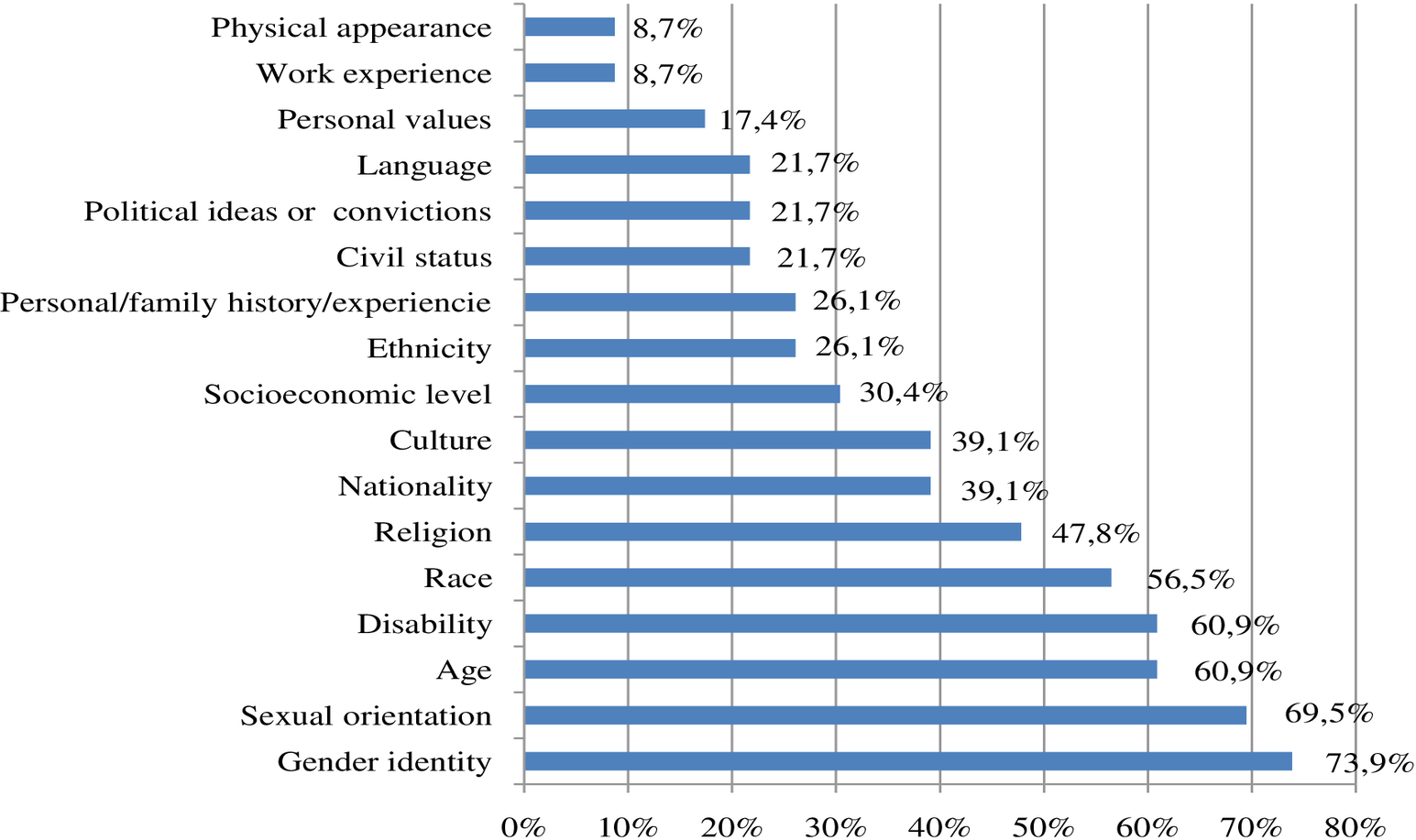
Source: PLOS One
Career services teams also need to ensure that their staff and resources are representatives of the diverse student population they serve by recruiting staff members from various backgrounds, providing cultural competency training, and integrating different perspectives into career services policies & procedures.
Obsolete Technology & Policies
Syntellis’ 2022 CFO Outlook for Higher Education report concluded that while institutional leaders are prioritizing data analytics for enrollment (67%) and financial aid (57%), nearly a third feel their institution lacks the tools to respond to changing conditions in higher education.
In the digital age, students expect to have access to updated job boards, virtual career fairs, and other technology-enabled resources, and career services teams must keep pace with these expectations.
But they often face issues with outdated or incompatible software, limited access to cutting-edge technological resources, or a lack of training for staff to use these tools effectively.
According to a 2019 NACE survey, only 34% of career centers reported having access to high-quality technology resources, and nearly 50% cited inadequate technology as a significant challenge.

Outdated policies and procedures can present significant challenges for career services teams in US colleges.
For example, many colleges may still rely on outdated career counseling or job placement policies that do not reflect current best practices or the rapidly changing needs of the job market.
This can limit the effectiveness of career services teams and hinder their ability to provide students with the guidance and resources they need to succeed.
Additionally, some colleges may have procedures that are not aligned with current service delivery models, which can further limit the effectiveness of career services teams.
George R. Boggs, the President and CEO Emeritus of the American Association of Community Colleges (AACC) and Superintendent/President Emeritus of Palomar College, stated "The mission of higher education is student learning, and all of our policies, procedures and practices must be aligned with that mission if our institutions are to remain relevant".
The post-pandemic environment is now making it dire for career centers to have decades-old tools, processes and mindsets make way for a more modern, hands-on approach that is customized, community-led and scalable, among other things.

Our Story & Vision
There are two kinds of people: those who complain about a problem and those who do something about it.
We try to be in the latter camp as much as we can. We saw the challenges facing students and career centers, the obstacles that are not letting them thrive fully, so we decided to do something about it.
6 years ago, our first groundbreaking product was an AI resume builder involving an instant score-based resume review and a JD matcher to help create targeted resumes. Then we added different modules for building cover letters, optimizing LinkedIn profiles, designing professional portfolios, and preparing for interviews. Within a short span of time, 150k+ students and professionals across the world were using our platform to transform their professional identities and boost their job-search.
But we wouldn't rest after this; this had just solved one part of the problem.
We built additional capabilities in the product to help career services teams drive the entire resume building and review process for their cohorts, complete with custom dashboards and analytics, thereby saving them 2-4 hours/student! Within a couple of years, 100+ US colleges such as State University of New York, Idaho State, Houston, Fairmont, Barton, Augusta, Brandeis, etc. had signed up for our offering and started arming their students with cutting-edge skills and capabilities.
Why did we prioritize that? We know that career services teams are an indispensable part of educational institutions that provide critical support and guidance to students as they chart their own unique career trajectories.
We envision a world where career centers assume their rightful place as the last line of defense for students before they enter the professional world and make their mark.
A world where they have access to all the latest tools and resources so that they can in turn equip the students to not just withstand but thrive in the job market.
Where the career services teams are themselves well-equipped and assisted by cutting-edge technology that makes everything easier for them - as it should.
Where students are at the forefront of all initiatives, and where they leave with the confidence to take on anything in the world.
By prioritizing the needs of their students and taking proactive steps to address the challenges they face, career services teams can create a supportive and inclusive environment that empowers all students to achieve their career goals.
Granted, there are multiple challenges and roadblocks in the way. Addressing these challenges requires a multifaceted approach that involves continuous investment in staff, resources, and technology, as well as a commitment to diversity, equity, and inclusion.
One potential solution to these challenges is investing in edtech products that can help streamline and automate career services processes, freeing up staff time and resources.
Hiration's next-gen ChatGPT-powered career platform is a godsend for both career services teams and students. This is a prime example of using cutting-edge technology to overcome a bunch of obstacles facing career centers in the US including lack of budget, personnel, student engagement, etc.
Want to know how Hiration can help your team achieve better student outcomes and unprecedented success? Reach out to us at team@hiration.com for more or book a free demo from the link below.



